1996 CHEVROLET CAVALIER spare tire
[x] Cancel search: spare tirePage 236 of 372
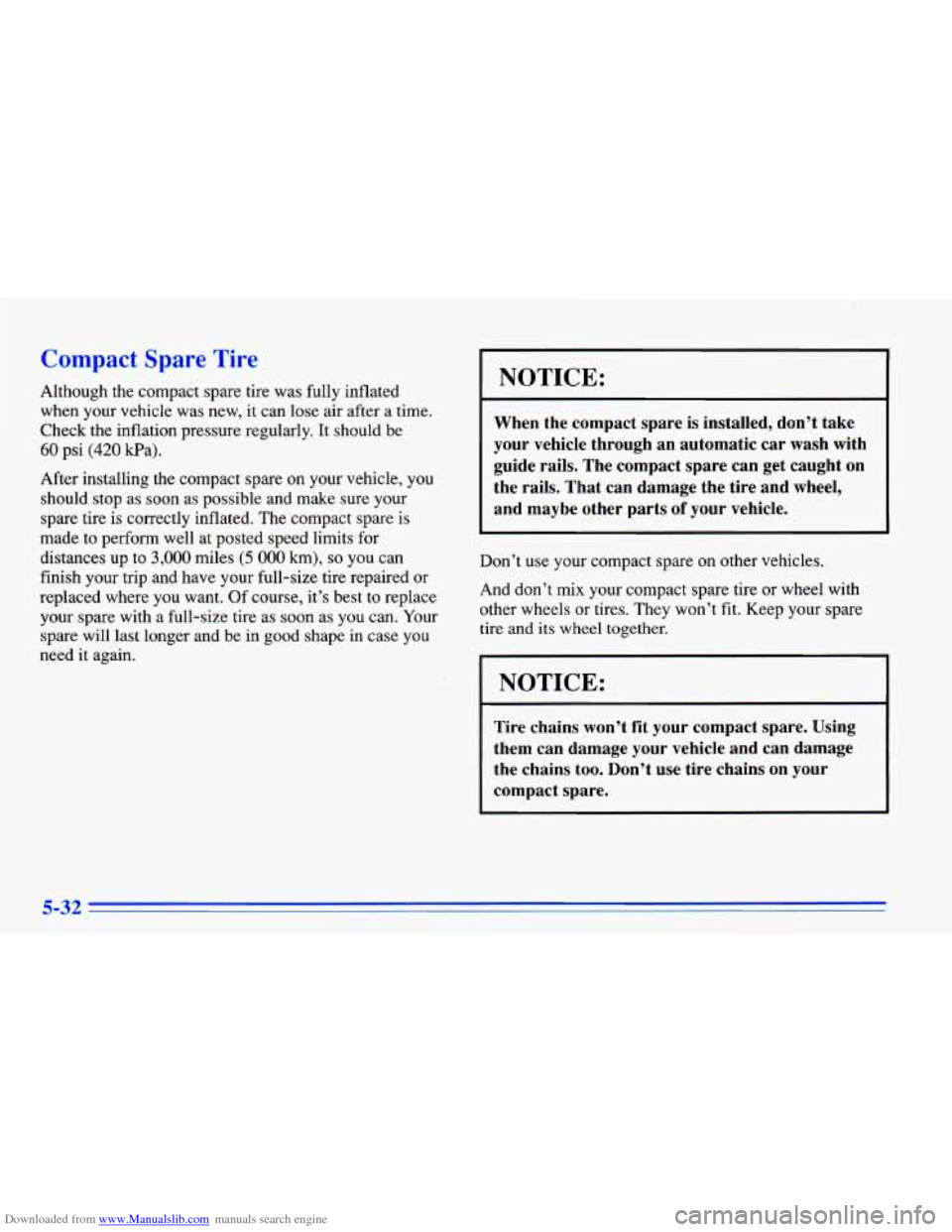
Downloaded from www.Manualslib.com manuals search engine Compact Spare Tire
Although the compact spare tire was fully inflated
when your vehicle was new, it can lose air after a time.
Check the inflation pressure regularly.
It should be
60 psi (420 ea).
After installing the compact spare
on your vehicle, you
should stop as soon as possible and make sure your
spare tire is correctly inflated. The compact spare is
made to perform well at posted speed limits for
distances up to
3,000 miles (5 000 km), so you can
finish your trip and have your full-size tire repaired or
replaced where you want.
Of course, it’s best to replace
your spare with a full-size tire
as soon as you can. Your
spare will last longer and be in good shape in case you
need it again.
NOTICE:
When the compact spare is installed, don’t take
your vehicle through an automatic
car wash with
guide rails. The compact spare can get caught on
the rails. That can damage the tire and wheel,
and maybe other parts
of your vehicle.
Don’t use your compact spare
on other vehicles.
And don’t mix your compact spare tire or wheel with
other wheels or tires. They won’t fit. Keep your spare
tire and its wheel together.
I NOTICE:
Tire chains won’t fit your compact spare. Using
them can damage your vehicle and can damage
the chains
too. Don’t use tire chains on your
compact spare.
5-32
Page 275 of 372
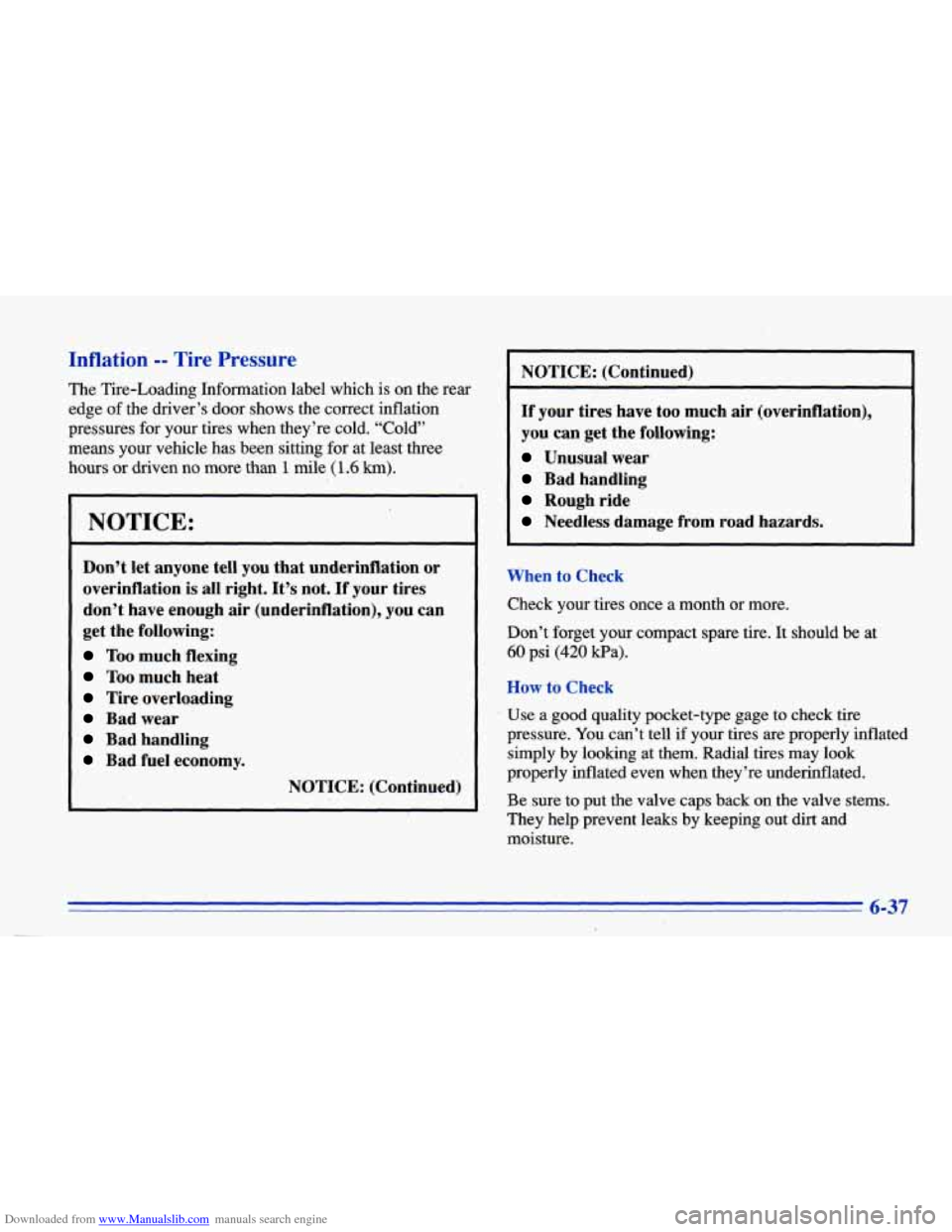
Downloaded from www.Manualslib.com manuals search engine Inflation -- Tire Pressure
The Tire-Loading Information label which is on the rear
edge
of the driver’s door shows the correct inflation
pressures for your tires when they’re cold. “Cold”
means your
vehicle has been sitting for at least three
hours or driven no more than
1 mile (1.6 km).
NOTICE:
Don’t let anyone tell you that underinflation or
overinflation is
all right. It’s not. If your tires
don’t have enough air (underinflation), you can
get the following:
Too much flexing
Too much heat
Tire overloading
Bad wear
Bad handling
Bad fuel economy.
NOTICE: (Continued) NOTICE:
(Continued)
If your tires have too much air (overinflation),
you can get the following:
Unusual wear
Bad handling
Rough ride
Needless damage from road hazards.
When to Check
Check your tires once a month or more.
Don’t forget your compact spare tire.
It should be at
60 psi (420 Pa).
How to Check
Use a good quality pocket-type gage to check tire
pressure. You can’t tell
if your tires are properly inflated
simply by looking at them. Radial tires may look
properly inflated even when they’re underinflated.
Be sure
to put the valve caps back on the valve stems.
They help prevent leaks by keeping out dirt and
moisture.
6-37
Page 276 of 372

Downloaded from www.Manualslib.com manuals search engine Tire Inspection and Rotation
1 Tires should be inspected every 6,000 to 8,000 miles
(10 000 to 13 000 km) for any signs of unusual wear.
If unusual wear is present, rotate your tires as soon as
possible and check wheel alignment. Also check for
damaged tires or wheels. See “When It’s Time for New
Tires” and “Wheel Replacement” later in this section for
more information.
The purpose of regular rotation is to achieve more
uniform wear for all tires on the vehicle. The first
rotation is the most important. See “Scheduled
Maintenance Services” in the Index for scheduled
rotation intervals. When rotating your tires, always use the Correct rotation
pattern shown here.
Don’t include the compact spare tire
in your tire
rotation.
After the tires have been rotated, adjust the front and
rear inflation pressures as shown on the Tire-Loading
Information label. Make certain that all wheel nuts are properly tightened. See “Wheel Nut Torque” in
the Index.
A CAUTION:
Rust or dirt on a wheel, or on the parts to which
it is fastened, can make wheel nuts become loose
after
a time. The wheel could come off and cause
an accident. When you change
a wheel, remove
any rust or dirt from places where the wheel
attaches to the vehicle. In an emergency, you can
use a cloth or a paper towel to do this; but be
sure to use
a scraper or wire brush later, if you
need to, to get all the rust or dirt
off. (See
“Changing
a Flat Tire” in the Index.)
,
6-38
Page 278 of 372
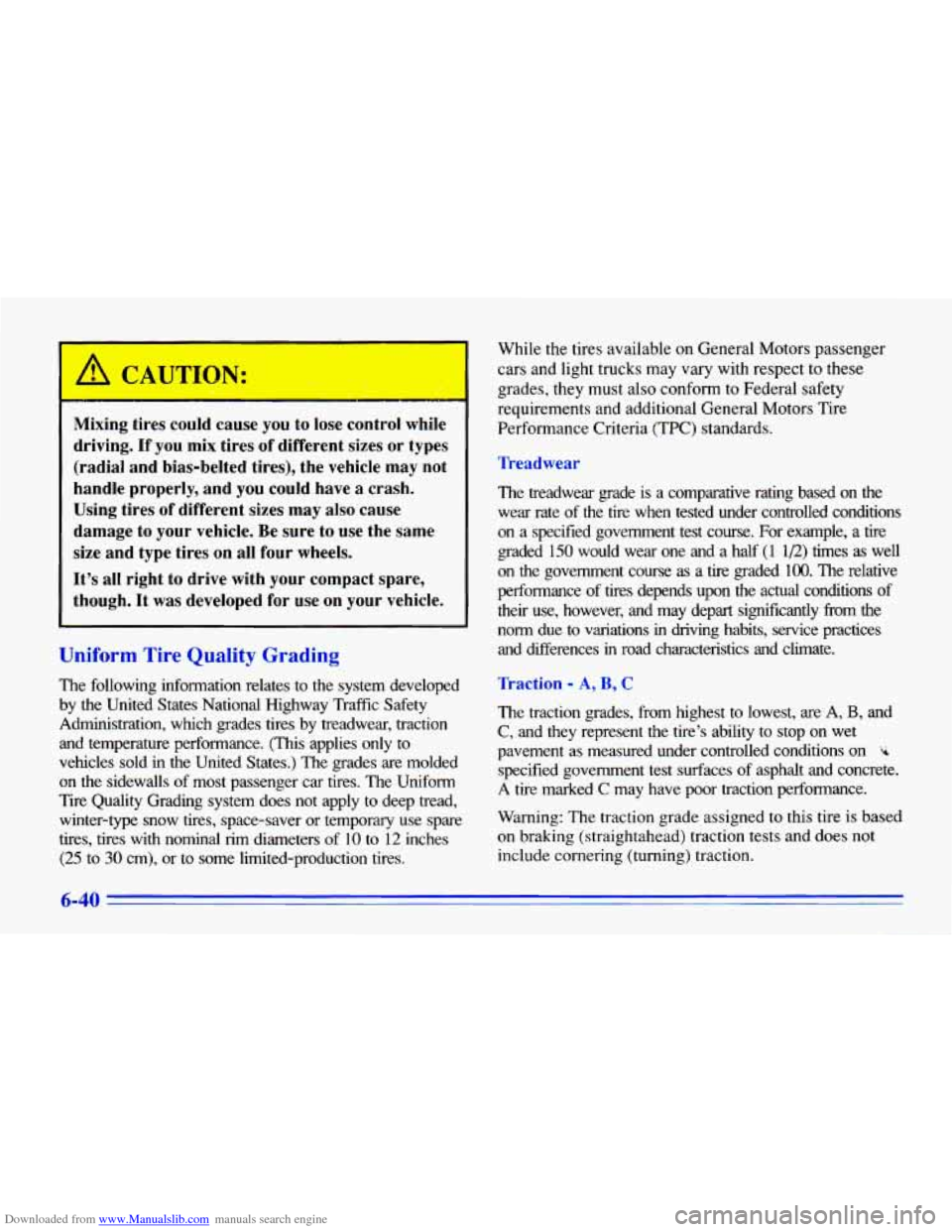
Downloaded from www.Manualslib.com manuals search engine Uniform Tire Quality Grading
The following information relates to the system developed
by the United States National Highway Traffic Safety Administration, which grades tires by treadwear, traction
and temperature performance.
(This applies only to
vehicles sold
in the United States.) The grades are molded
on the sidewalls of most passenger car tires. The Uniform
Tire Quality Grading system does not apply
to deep tread,
A CAUTION:
Mixing tires could cause you to lose control while
driving. If you mix tires of different sizes or types
(radial and bias-belted tires), the vehicle may not
handle properly, and
you could have a crash.
Using tires of different sizes may also cause
damage to your vehicle. Be sure to use the same
size and type tires on all four wheels.
It’s all right to drive with your compact spare,
though. It was developed for use on
your vehicle.
winter-type snow tires, space-saver or temporary use spare
tires, tires with nominal rim diameters of 10 to 12 inches
(25 to 30 cm), or to some limited-production tires. While
the tires available
on General Motors passenger
cars and light trucks may vary with respect
to these
grades, they must also conform
to Federal safety
requirements and additional General Motors Tire
Performance Criteria
(TPC) standards.
Treadwear
The treadwear grade is a comparative rating based on the
wear rate of the tire when tested under controlled conditions
on a specified government test course. For example, a tire
graded 150 would wear one and a half
(1 1/2) times as well
on
the government course as a tire graded 100. The relative
performance
of tires depends upon the actual conditions of
their use, however, and may depart significantly fiom the
norm due
to variations in driving habits, service practices
and differences in road characteristics and climate.
Traction - A, B, C
The traction grades, from highest to lowest, are A, B, and
C, and they represent the tire’s ability to stop on wet
pavement as measured under controlled conditions on
k
specified government test surfaces of asphalt and concrete.
A tire marked C may have poor traction performance.
Warning: The traction grade assigned to this tire is based
on braking (straightahead) traction tests and does not
include cornering (turning) traction.
6-40
Page 290 of 372
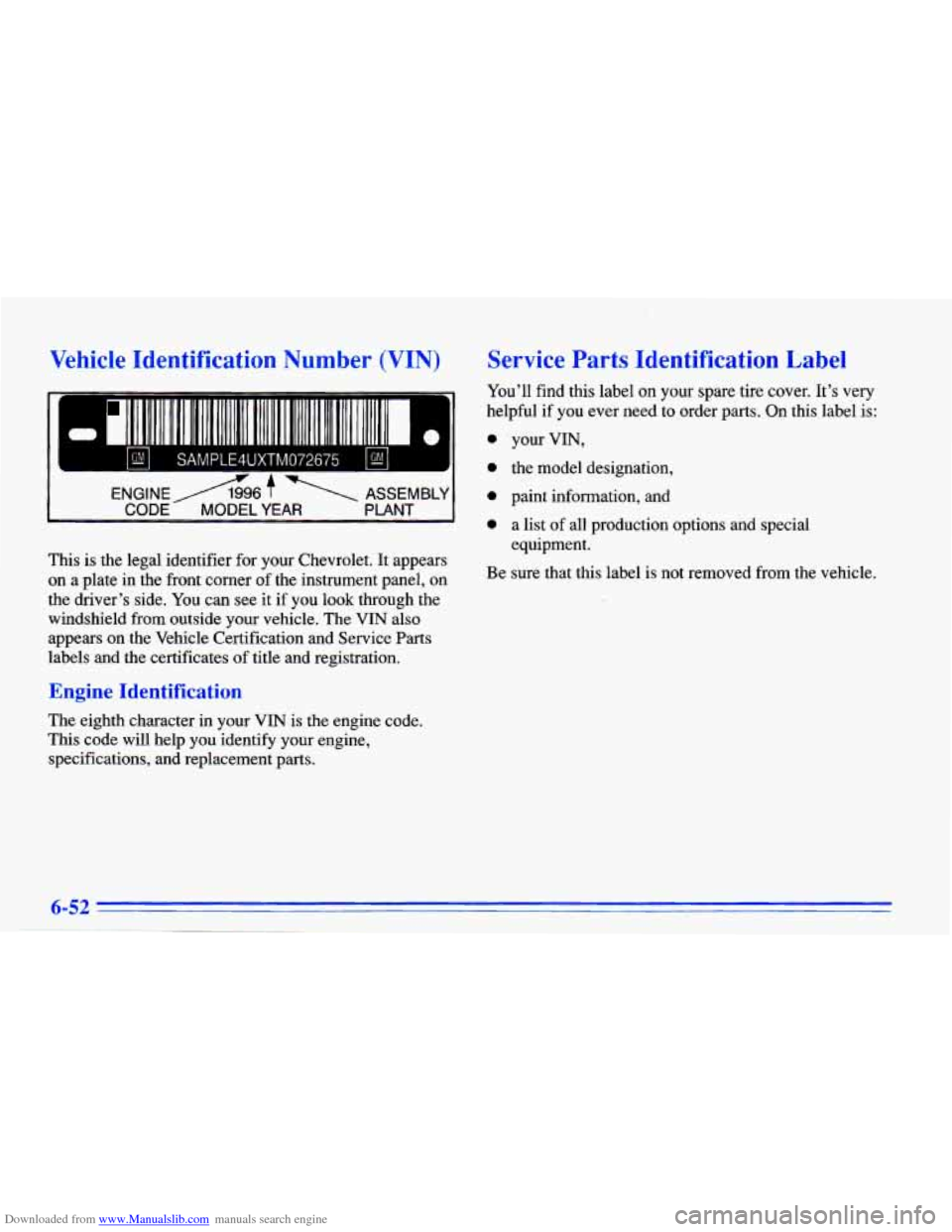
Downloaded from www.Manualslib.com manuals search engine Vehicle Identification Number (VIN)
r
- Dl I1 11111111 1111 111 111111 111 111111II 111111111111 111111111 111 0
SAMPLE4UXTM072675 L A
This is the legal identifier for your Chevrolet. It appears
on a plate
in the front comer of the instrument panel, on
the driver’s side. You can see it if you look through the
windshield from outside your vehicle. The
VIN also
appears on the Vehicle Certification and Service Parts
labels and the certificates of title and registration.
Engine Identification
The eighth character in your VIN is the engine code.
This code will help you identify your engine, specifications, and replacement parts.
Service Parts Identification Label
You’ll find this label on your spare tire cover. It’s very
helpful if you ever need to order parts. On this label
is:
a
0
0
a
your VIN,
the model designation,
paint information, and a list of all production options and special
equipment.
Be sure that this label is not removed from the vehicle.
6-52
Page 351 of 372

Downloaded from www.Manualslib.com manuals search engine 0 FREE Locksmith/Key Service (when keys are lost
on the road or locked inside)
0 FREE Flat Tire Service (spare installed on the road)
FREE Jump Start (at home or on the road)
FREE Fuel Delivery ($5 of fuel delivered on
Chevrolet/Geo offers Courtesy Transportation for
customers needing warranty service. Courtesy
Transportation will be offered in conjunction with the
coverage provided by the BUMPER-TO-BUMPER
New Vehicle Limited Warranty to eligible purchasers of
1996 Chevrolet/Geo passenger car and light duty trucks.
(Please see your selling dealer for details.)
Note:
Courtesy Care is available to Retail and
Retail Lease Customers operating 1996 and
newer Chevrolet/Geo vehicles for a period of
36 months/36,000 miles (60,000 km), whichever occurs
first. All
Courtesy Care services must be pre-arranged
by Chevrolet Roadside or Dealer Service Management. the road)
Basic Care and Courtesy Care are not part
of or
included in the coverage provided by the New Vehicle
Limited Warranty. Chevrolet reserves the right to
modify or discontinue
Basic Care and Courtesy Care
at any time. For complete program details, see your Chevrolet/Geo
dealer to obtain a Roadside Assistance Center brochure.
The Roadside Assistance Center uses companies that
will provide you with quality and priority service. When
roadside services are required, our advisors will explain any payment obligations that may be incurred for
utilizing outside services.
For prompt assistance when calling, please have the following available to give to the advisor:
0 Vehicle Identification Number
0 License plate number
0 Vehicle color
Vehicle location
Telephone number where you can be reached
0 Vehicle mileage
0 Description of problem
Please refer to the Roadside Assistance brochure inside
your owner information portfolio for full program
details.
8-5
Page 361 of 372
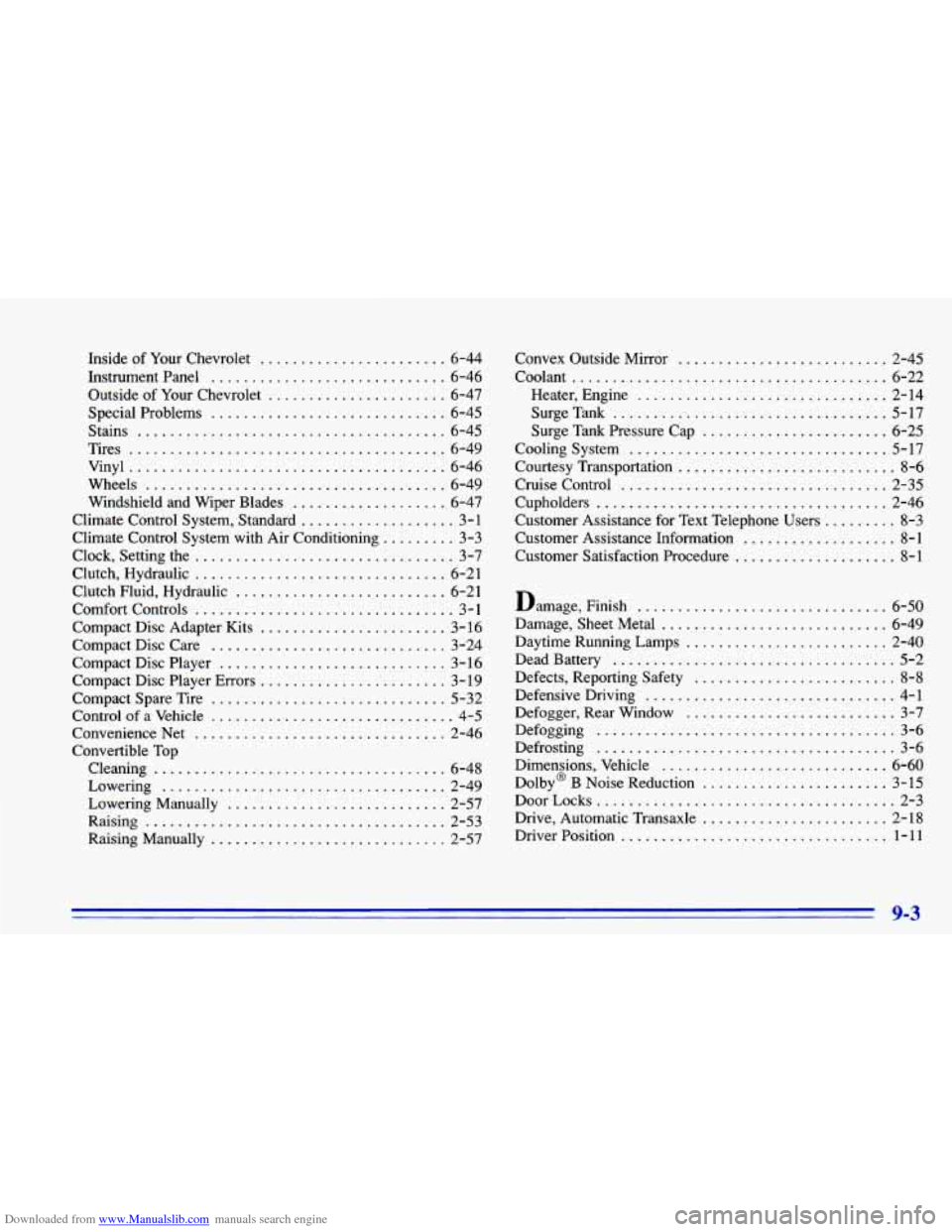
Downloaded from www.Manualslib.com manuals search engine Inside of Your Chevrolet ....................... 6-44
Instrument Panel
............................. 6-46
Outside of Your Chevrolet
...................... 6-47
Special Problems
............................. 6-45
Stains
...................................... 6-45
Tires
....................................... 6-49
Vinyl
....................................... 6-46
Wheels
..................................... 6-49
Windshield and Wiper Blades
................... 6-47
Climate Control System. Standard
................... 3-1
Climate Control System with Air Conditioning
......... 3-3
Clock. Setting the
................................ 3-7
Clutch. Hydraulic
............................... 6-21
Clutch Fluid. Hydraulic
.......................... 6-21
Comfort Controls
................................ 3- 1
Compact Disc Adapter Kits ....................... 3- 16
Compact Disc Care
............................. 3-24
Compact Disc Player
............................ 3- 16
Compact Disc Player Errors
....................... 3- 19
Compact Spare Tire
............................. 5-32
Control of a Vehicle
.............................. 4-5
Convenience Net ............................... 2-46
Convertible Top
Cleaning
.................................... 6-48
Lowering
................................... 2-49
Lowering Manually ........................... 2-57
Raising Manually
............................. 2-57
Raising
..................................... 2-53 Convex Outside Mirror
.......................... 2-45
Coolant
....................................... 6-22
Heater. Engine
............................... 2-14
Surge Tank Pressure Cap
....................... 6-25
Cooling System
................................ 5-17
Courtesy Transportation
........................... 8-6
Cruise Control
................................. 2-35
Cupholders
.................................... 2-46
Customer Assistance for Text Telephone Users
......... 8-3
Customer Assistance Information
................... 8-1
Customer Satisfaction Procedure
.................... 8-1
SurgeTank
.................................. 5-17
Damage. Finish
............................... 6-50
Damage. Sheet Metal
............................ 6-49
Daytime Running Lamps
......................... 2-40
Dead Battery
................................... 5-2
Defects. Reporting Safety
......................... 8-8
Defensive Driving
............................... 4-1
Defogger. Rear Window
.......................... 3-7
Defogging
..................................... 3-6
Defrosting
..................................... 3-6
Dimensions. Vehicle
............................ 6-60
DoorLocks
..................................... 2-3
Drive. Automatic Transaxle
....................... 2-18
DriverPosition
................................. 1-11
Dolby@ B Noise Reduction ....................... 3-15
Page 368 of 372
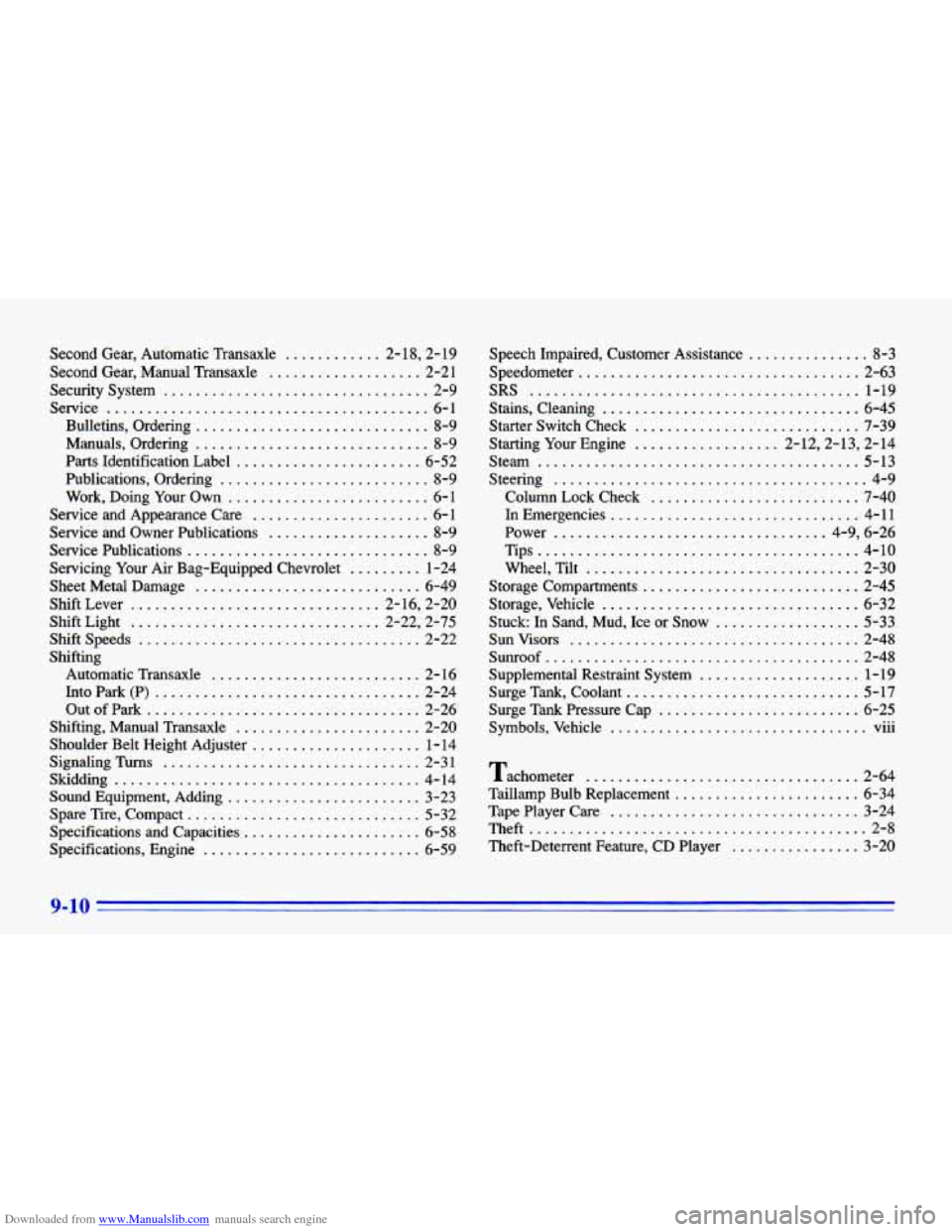
Downloaded from www.Manualslib.com manuals search engine Second Gear. Automatic Transaxle ............ 2- 18. 2. 19
Second Gear. Manual Transaxle ................... 2-21
Security System
................................. 2-9
Service
........................................ 6-1
Bulletins. Ordering
............................. 8-9
Manuals. Ordering
............................. 8-9
Parts Identification Label
....................... 6-52
Publications. Ordering
.......................... 8-9
Work. Doing
Your Own ......................... 6- 1
Service and Appearance Care ...................... 6-1
Service and Owner Publications
.................... 8-9
Service Publications
.............................. 8-9
Servicing Your Air Bag-Equipped Chevrolet
......... 1-24
Sheet Metal Damage
............................ 6-49
Shift Lever
............................... 2- 16. 2-20
Shift Light
............................... 2-22. 2-75
Shiftspeeds
................................... 2-22
Shifting
Automatic Transaxle
.......................... 2- 16
Into Park (P)
................................. 2-24
OutofPUk
.................................. 2-26
Shifting. Manual Transaxle
....................... 2-20
Shoulder Belt Height Adjuster
..................... 1-14
Skidding
...................................... 4-14
Sound Equipment. Adding
........................ 3-23
Spare Tire. Compact
............................. 5-32
Specifications and Capacities
...................... 6-58
Specifications. Engine
........................... 6-59
SignalingTurns
................................ 2-31 Speech Impaired. Customer Assistance
............... 8-3
Speedometer
................................... 2-63
Stains. Cleaning
................................ 6-45
Starter Switch Check
............................ 7-39
Starting Your Engine
.................. 2.12.2.13. 2.14
Steam
........................................ 5-13
Steering
....................................... 4-9
Column Lock Check
.......................... 7-40
In Emergencies
............................... 4-11
Power
.................................. 4.9. 6.26
Tips
........................................ 4-10
Wheel. Tilt
.................................. 2-30
Storage Compartments
........................... 2-45
Storage. Vehicle
................................ 6-32
Stuck:
In Sand. Mud. Ice or Snow .................. 5-33
Sunvisors
.................................... 2-48
Sunroof
....................................... 2-48
Supplemental Restraint System
.................... 1 . 19
Surge
Tank. Coolant ............................. 5-17
Surge Tank Pressure Cap ......................... 6-25
Symbols. Vehicle
................................ viii
Tachometer
.................................. 2-64
Taillamp Bulb Replacement
....................... 6-34
TapePlayerCare
............................... 3-24
Theft
.......................................... 2-8
Theft-Deterrent Feature. CD Player
................ 3-20
SRS ......................................... 1-19